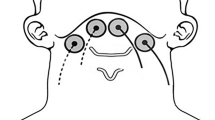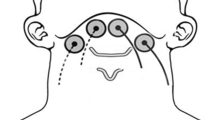Abstract
Prior research in swallowing physiology has suggested that using submental transcutaneous electrical stimulation (TES) with short pulse duration (PD) (300 μs) may enhance the impact on deep extrinsic tongue muscles, thereby pulling the tongue down during swallowing. However, it was unclear whether that same TES protocol could have a differential impact on hyolaryngeal kinematics and timing. This study aimed to compare the effect of submental TES with varying PDs on anterior and superior hyolaryngeal kinematics and timing both at rest and during swallowing in healthy adults. Twenty-four healthy adults between the ages of 22 and 77 participated in this study. Anterior and superior hyolaryngeal excursion magnitude and duration measures were collected using videofluoroscopic swallowing study. Each subject swallowed three 10 ml pudding trials under three conditions: no TES, TES with short PD (300 μs), and TES with long PD (700 μs). TES was delivered using two-channel surface electrodes in the submental area. In both short and long PD conditions, TES amplitude was gradually increased until participants reached their maximum tolerance level. Videofluoroscopic data were analyzed using VideoPad Video Editor and Image J programs. One-way repeated measure ANOVAs were conducted to identify within-subject effect of TES condition. For hyoid movement, TES with short PD selectively placed the hyoid bone on a more anterior position at rest and reduced anterior hyoid excursion during swallowing compared with the no TES condition. Regarding laryngeal movement, both TES protocols resulted in the larynx taking on a more anterior position at rest and reduced anterior laryngeal excursions during swallowing when compared with the no TES condition. Varying PDs had no significant effect on the superior hyoid and laryngeal movements at rest and during swallowing. Both TES protocols induced shorter hyoid elevation duration during swallowing Findings suggest that though both TES protocols demonstrated a comparable impact on reducing anterior laryngeal excursions, the TES protocol with short PD had an enhanced effect on reducing anterior hyoid excursion during swallowing. This reduced range of motion may result from stimulating the deep submental muscles, which primarily place the hyoid and larynx into a more forward position before swallowing onset. Overall, the TES protocol with short PD may have an increased benefit in facilitating swallowing in patients with dysphagia.








Similar content being viewed by others
References
Jacob P, Kahrilas PJ, Logemann JA, Shah V, Ha T. Upper esophageal sphincter opening and modulation during swallowing. Gastroenterology. 1989;97(6):1469–78. https://doi.org/10.1016/0016-5085(89)90391-0.
Cock C, Jones CA, Hammer MJ, Omari TI, McCulloch TM. Modulation of upper esophageal sphincter (UES) relaxation and opening during volume swallowing. Dysphagia. 2017;32(2):216–24. https://doi.org/10.1007/s00455-016-9744-4.
Steele CM, Bailey GL, Chau T, Molfenter SM, Oshalla M, Waito AA, Zoratto DCBH. The relationship between hyoid and laryngeal displacement and swallowing impairment. Clin Otolaryngol. 2011;36(1):30–6. https://doi.org/10.1111/j.1749-4486.2010.02219.x.
Kim Y, McCullough GH. Maximum hyoid displacement in normal swallowing. Dysphagia. 2008;23(3):274–9. https://doi.org/10.1007/s00455-007-9135-y.
Logemann JA, Rademaker A, Pauloski BR, Kelly A, Stangl-McBreen C, Antinoja J, Grande B, Farquharson J, Kern M, Easterling C, Shaker R. A randomized study comparing the shaker exercise with traditional therapy: a preliminary study. Dysphagia. 2009;24(4):403–11. https://doi.org/10.1007/s00455-009-9217-0.
McCullough GH, Kim Y. Effects of the mendelsohn maneuver on extent of hyoid movement and UES opening post-stroke. Dysphagia. 2013;28(4):511–9. https://doi.org/10.1007/s00455-013-9461-1.
Jang HJ, Leigh JH, Seo HG, Han TR, Oh BM. Effortful swallow enhances vertical hyolaryngeal movement and prolongs duration after maximal excursion. J Oral Rehabil. 2015;42(10):765–73. https://doi.org/10.1111/joor.12312.
White KT, Easterling C, Roberts N, Wertsch J, Shaker R. Fatigue analysis before and after shaker exercise: physiologic tool for exercise design. Dysphagia. 2008;23(4):385–91. https://doi.org/10.1007/s00455-008-9155-2.
Ding R, Larson CR, Logemann JA, Rademaker AW. Surface electromyographic and electroglottographic studies in normal subjects under two swallow conditions: normal and during the Mendelsohn manuever. Dysphagia. 2002;17(1):1–12. https://doi.org/10.1007/s00455-001-0095-3.
Groher ME, Crary MA. Dysphagia: clinical management in adults and children. St. Louis: Elsevier Health Sciences; 2015.
Park JW, Oh JC, Lee HJ, Park SJ, Yoon TS, Kwon BS. Effortful swallowing training coupled with electrical stimulation leads to an increase in hyoid elevation during swallowing. Dysphagia. 2009;24(3):296–301. https://doi.org/10.1007/s00455-008-9205-9.
Park JW, Kim Y, Oh JC, Lee HJ. Effortful swallowing training combined with electrical stimulation in post-stroke dysphagia: a randomized controlled study. Dysphagia. 2012;27(4):521–7. https://doi.org/10.1007/s00455-012-9403-3.
Park JS, Oh DH, Hwang NK, Lee JH. Effects of neuromuscular electrical stimulation combined with effortful swallowing on post-stroke oropharyngeal dysphagia: a randomised controlled trial. J Oral Rehabil. 2016;43(6):426–34. https://doi.org/10.1111/joor.12390.
Park JS, Hwang NK, Kim HH, Lee G, Jung YJ. Effect of neuromuscular electrical stimulation combined with effortful swallowing using electromyographic biofeedback on oropharyngeal swallowing function in stroke patients with dysphagia a pilot study. Medicine. 2019;98(44):e17702. https://doi.org/10.1097/MD.0000000000017702.
Park J, Kim Y, Lee H. Effortful swallow with resistive electrical stimulation training improved pharyngeal propulsion in post-stroke dysphagia. Int J Stroke. 2015;10:180–180.
Kim H, Park JW, Nam K. Effortful swallow with resistive electrical stimulation training improves pharyngeal constriction in patients post-stroke with dysphagia. J Oral Rehabil. 2017;44(10):763–9. https://doi.org/10.1111/joor.12538.
Crary MA, Carnaby GD. Adoption into clinical practice of two therapies to manage swallowing disorders: exercise-based swallowing rehabilitation and electrical stimulation. Curr Opin Otolaryngol Head Neck Surg. 2014;22(3):172–80. https://doi.org/10.1097/MOO.0000000000000055.
Barikroo A. Transcutaneous electrical stimulation and dysphagia rehabilitation: a narrative review. Rehabil Res Pract. 2020;2020:4865614. https://doi.org/10.1155/2020/4865614.
Humbert IA, Poletto CJ, Saxon KG, Kearney PR, Crujido L, Wright-Harp W, Payne J, Jeffries N, Sonies BC, Ludlow CL. The effect of surface electrical stimulation on hyolaryngeal movement in normal individuals at rest and during swallowing. J Appl Physiol. 2006;101(6):1657–63. https://doi.org/10.1152/japplphysiol.00348.2006.
Ludlow CL, Humbert I, Saxon K, Poletto C, Sonies B, Crujido L. Effects of surface electrical stimulation both at rest and during swallowing in chronic pharyngeal dysphagia. Dysphagia. 2007;22(1):1–10. https://doi.org/10.1007/s00455-006-9029-4.
Serel Arslan S, Azola A, Sunday K, Vose A, Plowman E, Tabor L, Singer M, Robison R, Humbert IA. Effects of submental surface electrical stimulation on swallowing kinematics in healthy adults: an error-based learning paradigm. Am J Speech-lang Pathol. 2018;27(4):1375–84. https://doi.org/10.1044/2018_AJSLP-17-0224.
Adams GR, Harris RT, Woodard D, Dudley GA. Mapping of electrical muscle stimulation using MRI. J Appl Physiol. 1993;74(2):532–7.
Alon G, Allin J, Inbar GF. Optimization of pulse duration and pulse charge during transcutaneous electrical nerve stimulation. Aust J Physiother. 1983;29(6):195–201. https://doi.org/10.1016/S0004-9514(14)60670-X.
Grill WM Jr, Mortimer JT. The effect of stimulus pulse duration on selectivity of neural stimulation. IEEE Trans Biomed Eng. 1996;43(2):161–6. https://doi.org/10.1109/10.481985.
Barikroo A, Carnaby G, Bolser D, Rozensky R, Crary M. Transcutaneous electrical stimulation on the anterior neck region: the impact of pulse duration and frequency on maximum amplitude tolerance and perceived discomfort. J Oral Rehabil. 2018;45(6):436–41. https://doi.org/10.1111/joor.12625.
Barikroo A, Hegland K, Carnaby G, Bolser D, Manini T, Crary M. Transcutaneous electrical stimulation on the submental area: the relations of biopsychological factors with maximum amplitude tolerance and perceived discomfort level. Dysphagia. 2020;35(2):301–7. https://doi.org/10.1007/s00455-019-10029-6.
Barikroo A, Hegland K, Carnaby G, Bolser D, Manini T, Crary M. The effects of electrical stimulation pulse duration on lingual palatal pressure measures during swallowing in healthy older adults. Dysphagia. 2019. https://doi.org/10.1007/s00455-019-09991-y.
Cichero JAY, Lam P, Steele CM, Hanson B, Chen JS, Dantas RO, Duivestein J, Kayashita J, Lecko C, Murray J, Pillay M, Riquelme L, Stanschus S. Development of international terminology and definitions for texture-modified foods and thickened fluids used in dysphagia management: the IDDSI framework. Dysphagia. 2017;32(2):293–314. https://doi.org/10.1007/s00455-016-9758-y.
Rasband W. ImageJ. Bethesda: National Institutes of Health; 1997–2009.
Seimert W. Adobe premiere pro CS5. Heidelberg: Hüthig Jehle Rehm; 2010.
Pearson WG Jr, Langmore SE, Yu LB, Zumwalt AC. Structural analysis of muscles elevating the hyolaryngeal complex. Dysphagia. 2012;27(4):445–51. https://doi.org/10.1007/s00455-011-9392-7.
Heck FM, Doeltgen SH, Huckabee ML. Effects of submental neuromuscular electrical stimulation on pharyngeal pressure generation. Arch Phys Med Rehabil. 2012;93(11):2000–7. https://doi.org/10.1016/j.apmr.2012.02.015.
Suiter DM, Leder SB, Ruark JL. Effects of neuromuscular electrical stimulation on submental muscle activity. Dysphagia. 2006;21(1):56–60. https://doi.org/10.1007/s00455-005-9010-7.
Baijens LWJ, Speyer R, Passos VL, Pilz W, Roodenburg N, Clave P. The effect of surface electrical stimulation on swallowing in dysphagic parkinson patients. Dysphagia. 2012;27(4):528–37. https://doi.org/10.1007/s00455-011-9387-4.
Lee HY, Hong JS, Lee KC, Shin YK, Cho SR. Changes in hyolaryngeal movement and swallowing function after neuromuscular electrical stimulation in patients with dysphagia. Ann Rehabil Med. 2015;39(2):199–209. https://doi.org/10.5535/arm.2015.39.2.199.
Restivo DA, Hamdy S. Pharyngeal electrical stimulation device for the treatment of neurogenic dysphagia: technology update. Med Devices (Auckl). 2018;11:21–6. https://doi.org/10.2147/MDER.S122287.
Funding
This study was supported by start-up funding from the Kent State University to PI Ali Barikroo.
Author information
Authors and Affiliations
Corresponding author
Ethics declarations
Conflict of interest
The authors declare that they have no conflict of interest.
Ethical Approval
All procedures performed in studies involving human participants were in accordance with the ethical standards of the institutional and/or national research committee and with the 1964 Helsinki declaration and its later amendments or comparable ethical standards.
Informed Consent
Informed consent was obtained from all individual participants included in the study.
Additional information
Publisher's Note
Springer Nature remains neutral with regard to jurisdictional claims in published maps and institutional affiliations.
Rights and permissions
About this article
Cite this article
Barikroo, A., Clark, A.L. Effects of Varying Transcutaneous Electrical Stimulation Pulse Duration on Swallowing Kinematics in Healthy Adults. Dysphagia 37, 277–285 (2022). https://doi.org/10.1007/s00455-021-10276-6
Received:
Accepted:
Published:
Issue Date:
DOI: https://doi.org/10.1007/s00455-021-10276-6




